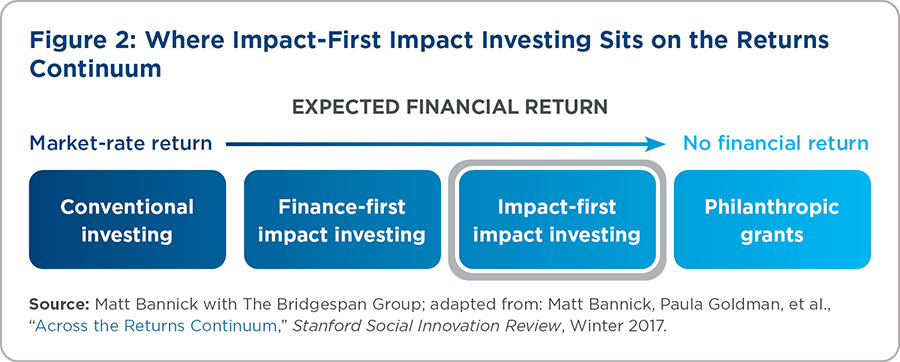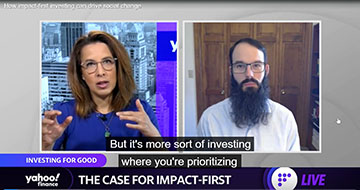Executive Summary
Impact investing has evolved from frontier to mainstream over the past decade as investors validated the prospect of achieving market-rate returns alongside social or environmental good. Few paid attention to a companion approach that put impact first and accepted below-market returns. But that’s changing. Impact-first investing is rapidly emerging from the neglected middle ground between market-rate impact investing and philanthropic grants. (See Figure 2.)
Download the Full ReportImpact-first impact investing, also called “catalytic capital,” is well-suited for investors “who want to support enterprises or funds that have high-impact potential but struggle to raise suitable financing because they are too early-stage or otherwise risky, expect to generate only modest returns, or require a longer investment time horizon,” explained the Catalytic Capital Consortium, a leading advocate.

A small number of family offices already have incorporated the impact-first approach as part of their overall investment strategy. Many others remain on the sidelines. Some fear that putting impact first means bad investing or that you don’t care about returns. Advocates maintain that neither is true. Impact-first simply means that the returns that matter most are measured in lives changed, not simply financial gain.
In more than three dozen interviews with HNWIs, family office directors, fund managers, and intermediaries, we heard how pioneers in the field, such as Omidyar Network, Blue Haven Initiative, Ceniarth, and Spring Point Partners, have put impact first by pursuing a three-step process: 1) clarifying a commitment to impact and 2) relying on trusted collaborators to set the stage for 3) choosing the investment approach that best fits their needs.

In this interview with Yahoo! Finance, Bridgespan Partner Michael Etzel breaks down impact investing and how it compares to ESG investing.
- Commitment to impact: Impact-first investing is one stop on a continuum between market-rate investing and philanthropy. Committing to impact first means embracing values that place social or environmental good ahead of financial return.
- Trusted collaborators: People who have accumulated wealth are accustomed to tapping friends and peers for advice. The same holds true for impact-first investing. Trust is a central mission of an emerging ecosystem of organizations that serve HNWIs and family offices as they venture into impact-first investing.
- Pick an approach that fits your needs: This is an operational choice with three broad—sometimes overlapping—options: outsource to advisers and fund managers, taking a lean approach with one or two impact specialists who complement existing family office staff, or hiring a team and building an organization dedicated to impact investing.
Regardless of the investment approach, when the time comes to choose what to invest in, there’s something for everyone, a tribute to the changes in the impact-first area over the past several years. HNWIs and families can turn to the growing number of investment funds that source and conduct due diligence on impact businesses. Some funds are agnostic about the types of businesses they choose. Others target specific sectors, themes, or geographies.
Wealth holders who want to get started can test the waters with a modest commitment of 10 percent of assets, and gain the experience and confidence to go bigger in the future. If impact-first means leaving returns on the table in exchange for social or environmental benefit, it’s a tradeoff worth making.
Stay up to date with our latest impact investing research and articles. Sign up below.
By signing up to receive our Impact Investing alerts, you agree to our terms of service. We will never sell or share your personal information with anyone outside Bridgespan without your express permission.





